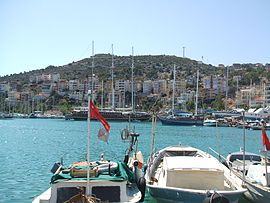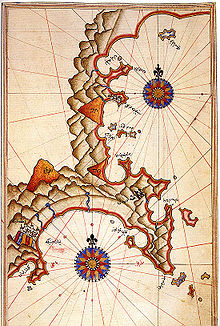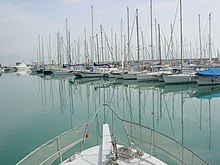Finike
Finike | |
|---|---|
 Port of Finike | |
 Map showing Finike District in Antalya Province | |
| Coordinates:36°18′N30°09′E/ 36.300°N 30.150°E | |
| Country | Turkey |
| Province | Antalya |
| Government | |
| • Mayor | Mustafa Geyikçi (CHP) |
| Area | 768 km2(297 sq mi) |
| Elevation | 3 m (10 ft) |
| Population (2022)[1] | 49,720 |
| • Density | 65/km2(170/sq mi) |
| Time zone | UTC+3(TRT) |
| Postal code | 07740 |
| Area code | 0242 |
| Website | www |
Finike(Turkish:[feˈnice]), the ancientPhoenixorPhoinix(Ancient Greek:Φοῖνιξ),[2]also formerlyPhineka,[3]is a municipality anddistrictofAntalya Province,Turkey.[4]Its area is 768 km2,[5]and its population is 49,720 (2022).[1]It lies on theMediterraneancoast ofAntalya ProvinceinTurkey,to the west of the city ofAntalya,along theTurkish Riviera.It is located on the southern shore of the Teke peninsula, and the coast here is a popular tourist destination. However, Finike is best known for its oranges, the symbol of the town.
History[edit]
For centuries Finike, then namedPhoenix(orPhoinix;Ancient Greek:Φοῖνιξ) was a port town ofancient Lycia,near themountain of the same name.[6][7]It was a trading port and the main port ofLimyra,the capital city ofLycia.Phoenix was said to have been founded byPhoeniciansin the 5th centuryBC,and thus named after its founders.
The area has been inhabited for much longer than that; archaeologists have found evidence near the town ofElmalıshowing that the Teke peninsula has been settled since 3000 BC (although on the coast nothing has been uncovered dating before 2000 BC).
Trade along the coast was established first by thePersians,who relinquished Lycia to the armies ofAlexander the Great.However, the coast was always vulnerable to forces fromSyria,EgyptandRhodesuntil it was brought within the empire of theAncient Romansand the succeedingByzantines.Even then the Byzantines were threatened by the Arabian armies coming from the Arabian Peninsula. TheBattle of the Mastsbetween the Arab and Byzantine fleet took place near Finike in 654. Eventually the area was lost to theSeljuk Turksin the 13th century. These were succeeded by theOttoman Empirefrom 1426.
The town was inhabited by Greeks prior to the 1923population exchange between Greece and Turkiye.[8]
Composition[edit]
There are 26neighbourhoodsin Finike District:[9]
Climate[edit]
Finike has ahot-summer Mediterranean climate(Köppen:Csa),[10]with very hot, muggy, virtually rainless summers, and mild winters with heavy rain.
| Climate data for Finike (1991–2020) | |||||||||||||
|---|---|---|---|---|---|---|---|---|---|---|---|---|---|
| Month | Jan | Feb | Mar | Apr | May | Jun | Jul | Aug | Sep | Oct | Nov | Dec | Year |
| Mean daily maximum °C (°F) | 16.3 (61.3) |
16.7 (62.1) |
19.0 (66.2) |
22.2 (72.0) |
26.4 (79.5) |
31.3 (88.3) |
34.5 (94.1) |
34.8 (94.6) |
31.7 (89.1) |
27.3 (81.1) |
22.2 (72.0) |
17.9 (64.2) |
25.1 (77.2) |
| Daily mean °C (°F) | 11.5 (52.7) |
12.0 (53.6) |
14.1 (57.4) |
17.1 (62.8) |
21.2 (70.2) |
25.8 (78.4) |
28.8 (83.8) |
29.1 (84.4) |
25.8 (78.4) |
21.5 (70.7) |
16.7 (62.1) |
13.0 (55.4) |
19.8 (67.6) |
| Mean daily minimum °C (°F) | 7.8 (46.0) |
7.9 (46.2) |
9.4 (48.9) |
12.1 (53.8) |
16.0 (60.8) |
20.0 (68.0) |
22.9 (73.2) |
23.3 (73.9) |
20.1 (68.2) |
16.5 (61.7) |
12.4 (54.3) |
9.4 (48.9) |
14.9 (58.8) |
| Averageprecipitationmm (inches) | 208.92 (8.23) |
144.17 (5.68) |
79.48 (3.13) |
47.91 (1.89) |
21.37 (0.84) |
8.75 (0.34) |
1.91 (0.08) |
1.86 (0.07) |
14.49 (0.57) |
71.36 (2.81) |
129.08 (5.08) |
236.32 (9.30) |
965.62 (38.02) |
| Average precipitation days(≥ 1.0 mm) | 10.7 | 8.3 | 6.3 | 4.1 | 2.7 | 1.3 | 1.5 | 1.5 | 1.9 | 4.4 | 6.1 | 10.3 | 59.1 |
| Averagerelative humidity(%) | 67.7 | 66.8 | 66.5 | 67.1 | 67.3 | 62.3 | 59.6 | 60.3 | 61.1 | 63.4 | 64.7 | 68.0 | 64.6 |
| Mean monthlysunshine hours | 142.3 | 158.1 | 212.8 | 247.9 | 297.7 | 339.2 | 362.8 | 336.6 | 286.7 | 242.3 | 176.6 | 135.2 | 2,920.8 |
| Source:NOAA[11] | |||||||||||||
Demographics[edit]

The district has a population of 49,720 (2022).[1]The town itself has 21,765 inhabitants.[12]
Finike today[edit]

The local economy depends on agriculture, particularly oranges and other citrus fruits. This is supplemented by income from tourism in the summertime, although because of the lucrative orange production and the distance from Antalya, Finike has not seen the large-scale tourism boom that has so radically changed the other coastal districts of Antalya. Finike is a quiet district where people buzz around on mopeds going about their daily lives. Indeed, many of the visitors that Finike does attract are retired people in search of relaxation. That's mostly because of the construction policy of 1980. That policy made the land more suitable for investment in agriculture rather than in hotels, luxury apartments and other tourist attractions.
A type of pale limestone is quarried at Limyra, and sold as a decorative building material. It is cream colored with a homogeneous structure. Moreover, it is extremely light and that makes it ideal for building walking alleys and streets where only light vehicles pass by. The geologist classify the Limura limestone as with medium density.[13]
The port of Finike is now a yacht marina, and has a small fishing fleet. The coast is rich in marine life, including sea turtles, and fish, including local specialitiesred porgy(Sparidae) andgrouper(Epinephelus); other fish found along the coast includeleerfish(Carangidae) and the more widespread Mediterranean varieties such asbluefish,sea bream,sea bass,withswordfish,sardinesand others found further out to sea. However, the coast suffers from overfishing, and many varieties, including the porgy, are in decline.
The beaches of Finike are an important nesting ground forCaretta carettasea turtles, and the rocky parts of the coast are used by the rareMediterranean monk seal.
Places of interest[edit]
- The ruins of Limyra are to be seen three miles east of the Finike, they consist of a theatre, tombs, Sarcophagi, bas-reliefs, Greek and Lycian inscriptions, etc.
- The ancient city ofArycanda,in a narrow valley off the road to Elmalı.
- The ruins ofTrysawith a carved frieze depictingTheseus,on the road toKaş.
- The small village ofTuruncova,hidden in a small valley ofTaurus Mountains,has preserved its traditional lifestyle and culture.
- The cave ofSuluin.
- Wreck of a Phoenician merchant ship from about 1200 BC inCape Gelidonya
There are doubtless many more places of antiquity that need to be restored.
See also[edit]
References[edit]
- ^abc"Address-based population registration system (ADNKS) results dated 31 December 2022, Favorite Reports"(XLS).TÜİK.Retrieved22 May2023.
- ^Lund University.Digital Atlas of the Roman Empire.
- ^A Gazetteer of the World: Or, Dictionary of Geographical Knowledge.Vol. 4. 1859. p. 520.RetrievedJanuary 12,2015.
- ^Büyükşehir İlçe Belediyesi,Turkey Civil Administration Departments Inventory. Retrieved 8 June 2023.
- ^"İl ve İlçe Yüz ölçümleri".General Directorate of Mapping.Retrieved22 May2023.
- ^Richard Talbert,ed. (2000).Barrington Atlas of the Greek and Roman World.Princeton University Press. p. 65, and directory notes accompanying.ISBN978-0-691-03169-9.
- ^Lund University.Digital Atlas of the Roman Empire.
- ^Nicholas Doumanis (22 November 2012).Before the Nation: Muslim-Christian Coexistence and Its Destruction in Late-Ottoman Anatolia.Oxford University Press. pp. 39–.ISBN978-0-19-954704-3.
- ^Mahalle,Turkey Civil Administration Departments Inventory. Retrieved 22 May 2023.
- ^"Table 1 Overview of the Köppen-Geiger climate classes including the defining criteria".Nature: Scientific Data.
- ^"World Meteorological Organization Climate Normals for 1991-2020 — Finike".National Oceanic and Atmospheric Administration.RetrievedJanuary 15,2024.
- ^"Finike".citypopulation.de.Retrieved13 June2023.
- ^Turkey GuideArchived2012-01-11 at theWayback Machine
External links[edit]
- Turkish Riviera
- Antalya
- Populated places in Antalya Province
- Tourist attractions in Antalya Province
- Fishing communities in Turkey
- Populated coastal places in Turkey
- Districts of Antalya Province
- Former Greek towns in Turkey
- Lycia
- Finike District
- Phoenician colonies in Turkey
- Metropolitan district municipalities in Turkey
- Cittaslow



